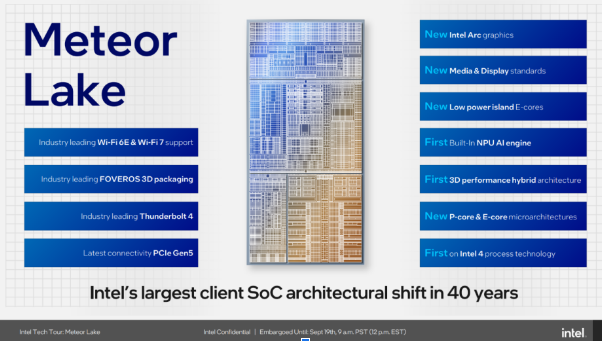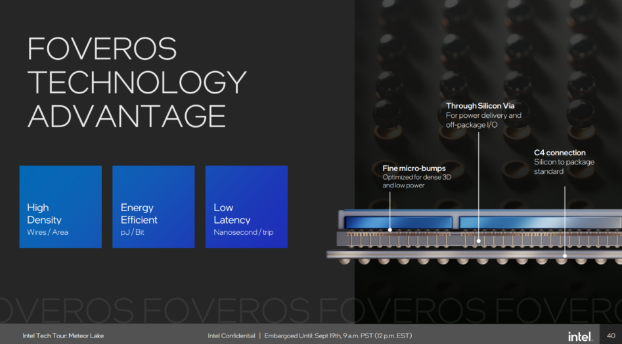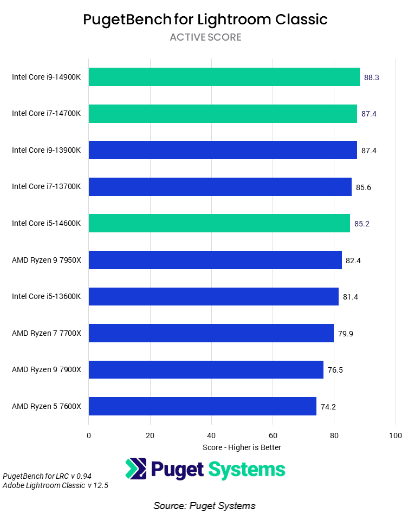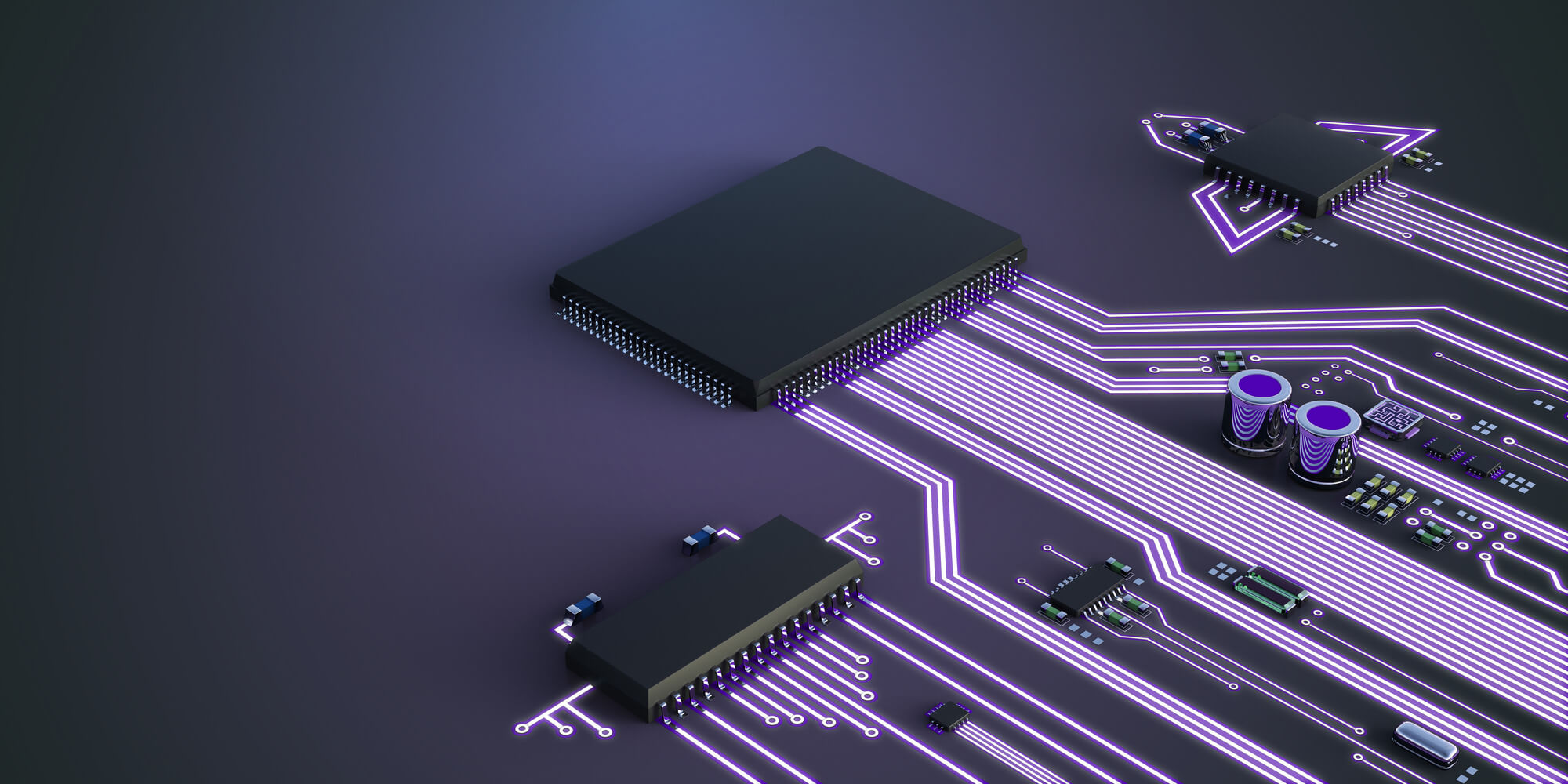- Intel 14th Gen Release Date
- Why the Short Break Between 13th and 14th Gen?
- Key Improvements in the Intel 14th Gen CPU
- Other key improvements in the new Intel processors
- Comparison: Is Intel 14th Gen a Carbon Copy of the Intel 13th Gen?
- Does Intel 14th Gen Improve Computer Productivity?
- Adobe Lightroom Classic productivity review
- Does Intel 14th Gen Have Overheating Issues?
- What Are the Available Support and Warranties for Intel’s 14th Generation Processors?
- Summing Up
- FAQ
This current Intel generation CPU is specifically designed for laptops and has many changes.
For example, Meteor Lake is the first set of PC chips to use tile-based architecture and include dedicated AI hardware for every chip.
Even though it’s unusual and risky, Intel did it to improve its technology and stay ahead of its competitor, AMD.
But is Meteor Lake better than its predecessor, the 13th generation? Not exactly. Intel’s 14th gen may be what the 13th was supposed to be.
This guide will explore the key improvements of the Intel 14th gen CPU, compare it to previous generations, and see what experts say.
Let’s begin.
Intel 14th Gen Release Date
When is Intel’s 14th gen coming out?
The official Intel 14th gen release date was December 14, 2023. There are several chips available now in laptops made by Intel’s partners.
The company has launched eight new CPUs, with three more coming in 2024. However, the new Intel processors won’t be available to the DIY desktop PC market.
Even though Intel says laptops equipped with Meteor Lake are available, it may take some time to be widely available to the public.
According to Intel, the Intel 14th gen chips will come with over 230 unique designs, giving you different options.
Why the Short Break Between 13th and 14th Gen?
Intel launched its 13th gen processor on October 20, 2022, only 14 months before the newest Intel CPU was released.
If you check the previous Intel processors’ release dates, the short interval seems like a regular trend. This could be because Intel follows the tick-tock model for processor development.
In this model, the “tick” streamlines the manufacturing process to produce smaller and more power-efficient chips, and the “tock” adds new microarchitecture to improve performance.
These processes occur about 12 to 18 months.
The 13th gen uses the “tick” model because they use the same 10nm SuperFin process as the 12th gen processors but with some improvements.
Meteor Lake uses the “tock” model with a new microarchitecture.
Key Improvements in the Intel 14th Gen CPU
Meteor Lake has several new features and improvements. Let’s go through them:
1. Intel 14th gen processors are Intel’s first Core Ultra chips

Photo Credit: Intel
Intel said earlier this year that they were rebranding its Core processors for simpler names. But Meteor Lake is more than that.
The company has revamped nearly every aspect of chips, such as the architecture’s layout, new capabilities and features, promising more improvements in the future.
The current Intel generation has many changes, including its manufacturing process and a stacked 3D design combining CPU parts.
It also expands on the high-power and low-power processor cores approach Intel introduced a few years ago.
Intel has removed the “i” from the i3, i5, i7, and i9 tiers for its Core chips, and Meteor Lake will be the first generation of Intel Core Ultra processors.
2. Meteor Lake uses the new Intel 4 technology
Intel has switched to a new Intel 4 technology, which is a major upgrade. This 7-nanometer (7nm) manufacturing process uses extreme ultraviolet (EUV) lithography.
It’s a chip-making process that enables smaller chips by packing more transistors into a given surface area. The advantage of using this process is that it can improve scaling and power efficiency.
The Intel 4 technology is expected to yield a 20% increase in performance per watt compared to the previous 10nm Intel 7 process.
3. Foveros 3D die stacking: Intel’s new packaging tech

Photo Credit: Intel
Foveros is Intel’s new packaging technology that uses 3D stacking to combine multiple component tiles into a single chip.
This allows Intel to use a more customizable disaggregated design, which is better than their previous methods.
The change from the monolithic design allows Intel to customize each processor component individually. It helps optimize and combine specific functions into a highly efficient 3D stack.
The new packaging technology is a significant improvement because Intel can now accurately build processors from pre-tested parts. This removes the need for post-fabrication binning.
This helps manufacturers to effectively distribute chips among their product lines, maintain performance optimization, guarantee quality control, and develop a range of product tiers at different pricing points.
Binning helps reduce waste, satisfy market demands, and give customers processors designed to match their needs.
Components that don’t meet the fabricator’s standard are packaged as “lesser” versions. That’s how we get different processor power tiers like Intel i9, Intel i7, Intel i5, etc.
The higher the number, the better.
4. The Intel 14th gen chip includes AI in the new architecture.
Intel usually doesn’t change its architecture and production process at the same time. But that has changed with the new Intel CPU.
Besides the new Intel 4 technology, Intel has introduced new CPU core architectures and integrated dedicated AI hardware.
CPU core types
The current Intel generation has two different types of CPU cores, just like the previous two generations of Intel PC CPUs.
The E-cores focus on efficiency, while the P-cores focus on raw power.
The new Crestmont E-cores increase instructions per clock by 4% to 6%, while the Redwood Cove P-cores in the Intel 14th gen CPU offer efficiency gains.
SoC tile improvements
The newest Intel CPU has additional low-power E-cores on the system-on-a-chip (SoC) tile, which differs from the compute tile housing the remaining cores.
It can improve battery life by keeping the power-demanding compute tile inactive for specific tasks.
This includes peripheral controllers, power management, memory, input/output interfaces, GPUs, and CPUs.
Because of the integration of several functionalities onto a single chip, SoCs are frequently used in devices such as smartphones, tablets, and Internet of Things (IoT) devices.
These products offer benefits like decreased size, power efficiency, and cost-effectiveness.
Integrated AI acceleration
The SoC tile also integrates a neural processing unit (NPU) to speed up AI operations.
Even though the software must specifically support this new AI hardware, you can benefit greatly from it.
You can take your user experience to a new level using AI-powered features without waiting for cloud services or overburdening the CPU and GPU.
NPUs excel in matrix operations and parallel processing. They have a dedicated architecture designed with AI workloads in mind.
This offers excellent computational performance and efficiency per watt.
Alongside general-purpose processors, NPUs are usually included in systems, advancing AI applications like speech recognition, image recognition, and natural language comprehension.
Other key improvements in the new Intel processors
- Enhanced overclocking capabilities include higher frequencies, support for DDR5 XMP, per-core thermal throttling, and an AI-assisted overclocking tool that yields a significant two-bin frequency performance increase.
- Meteor Lake, including the Core i9 14900k, improves single and multi-threaded performance, allows overclocking, and remains compatible with existing setups.
- The new Intel CPU has faster wireless connectivity with Wi-Fi 7, increased bandwidth, and charging capabilities with Thunderbolt 5. You also get enhanced gaming performance with Intel Application Performance Optimization (APO).
- Machine learning is used to suggest ideal temperature and cooling system adjustment alternatives to improve overall performance.
- The Intel Core i9 14900K offers smooth gameplay with high frame consistency, which is perfect for sharing your gameplay if you’re a streamer.
- Intel raised operating frequencies by 10%-15%.
- The protection threshold increased from 100°C in the 13th generation to 115°C in the new Intel CPU.
Comparison: Is Intel 14th Gen a Carbon Copy of the Intel 13th Gen?
Some users call the Intel 14th gen “Raptor Lake refresh,” and some reviewers, like JaysTwoCents, call it “13th gen plus.”
In other words, there’s not much difference between the 13th and 14th gen. But is this true?
In certain aspects, yes. For example, Meteor Lake isn’t the first processor with AI hardware.
Raptor Lake had a dedicated AI processor. But it was only for a few models. In the new Intel CPU, the AI processor is on every chip.
So there is a difference. However, on a larger scale, it’s the same.
Let’s find out more.
The Intel Core i9-14900K and i9-13900K are similar.
The i9-14900K and the i9-13900K CPUs are identical except for clock speeds. The 14900K can reach up to 6.0 GHz with the Thermal Velocity Boost, while the 13900K can only reach 5.8 GHz.
With a power range of 125W to 253W, both CPUs retain the same architecture, die, and physical design.
In terms of performance, the i9-14900K shows a slight increase of 1 to 5% in various programs.
When it comes to gaming, the i9-14900K offers an average advantage of 2 to 3% at 1080p. But this is such a small difference that users won’t even notice it.
Intel claims they’ve improved certain aspects like pull power and how the CPU reacts. However, the improvement is so small that it’s actually unnoticeable.
Intel Core i7-14700K vs. i7-13700K
The only noticeable difference between Core i7-13700K and Core i7-14700K is the additional two cores to the i7-14700K processor.
Besides the four E-cores, there is a little increase in clock speeds: 200MHz for the P-cores and 100MHz for the E-cores.
Because of the additional E-cores, the Core i7-14700K performs about 10% better in multi-threaded applications.
But when it comes to gaming, the difference is barely noticeable because the Core i7-14700K performs about 2%-3% less than the i7-13700K.
The Core i9-13900K still surpasses the 14700K in productivity and gaming. However, the 14700K consumes more power than the 13700K because of the additional two E-cores.
But this is not a major change because the 14900K and the 13900K still consume more power than the i7 series.
Intel 13th and 14th Gen Specification Comparison Table
Here’s a side-by-side comparison of the Intel 13th gen (i9-13900K) and 14th gen (i5-14600K, i7-14700K, i9-14900K) processors:
| Specification | i9-13900K | i5-14600K | i7-14700K | i9-14900K |
| Base Clock Speed | 3.00 GHz/2.20 GHz | 3.5 GHz | 3.4 GHz | 3.2 GHz |
| Cache (Smart Cache/L2 Cache) | 36 MB/32 MB | 24 MB (Smart Cache) | 33 MB (Smart Cache) | 36 MB (Smart Cache) |
| Total Cores/Threads | 24 cores/32 threads (8 P-Cores, 16 E-Cores) | 14 cores/20 threads (6 P-Cores, 8 E-Cores) | 20 cores/28 threads (8 P-Cores, 12 E-Cores) | 24 cores/32 threads (8 P-Cores, 16 E-Cores) |
| DDR Support | DDR5 up to 5600, DDR4 up to 3200 | DDR5-5600/ DDR4 3200 | DDR5-5600/ DDR4 3200 | DDR5-5600/ DDR4 3200 |
| Graphics | Intel® UHD Graphics 770 | Intel® UHD Graphics 770 | Intel® UHD Graphics 770 | Intel® UHD Graphics 770 |
| Process Node | 10nm (Intel 7) | 10nm (Intel 7) | 10nm (Intel 7) | 10nm (Intel 7) |
| Socket Compatibility | LGA 1700 | LGA 1700 | LGA 1700 | LGA 1700 |
| Max Turbo Frequency | 5.4 GHz/4.30 GHz | 5.6 GHz | 5.8 GHz | 6 GHz (Turbo) |
Related: Intel Processor Generations in a Timeline: History and Evolution
Does Intel 14th Gen Improve Computer Productivity?
If your goal is to improve your productivity, the Intel 14th gen processors offer different options. Let’s break down their performance and compare them with other processors from AMD:
General productivity and cost efficiency
If your priority is productivity, you can still get it with the Intel 14th gen CPU. However, the Core i9-13900K performs better than the 14700K.
In terms of cost efficiency and productivity, the Core i7 is the best option, according to the TechSpot review.
Based on the same review, there’s no major difference between the 14600K and AMD Ryzen 7 7700X. So, you can choose any of these options.
Higher demanding work (video editing)
When it comes to photography, video editing, and motion graphics, the Intel Core processors are better.
However, AMD typically performs better when demanding multi-threaded applications like rendering and compiling.
Check the table below for the specifications for Intel’s 13th and 14th gen CPUs and AMD’s Ryzen 7000-series CPUs.
You can find more information on Inter Ark and AMD Ryzen page.
Note: Highlighted are the newest Intel CPU models.
| CPU Model | Maximum Boost Clock | Cores (Threads) | TDP (Max) |
| AMD Ryzen 9 7950X | 5.7 GHz | 16 (32) | 170 W |
| Intel Core i9-14900K | 6 GHz | 8P + 16E (32) | 125 W (253 W) |
| Intel Core i9-13900K | 5.8 GHz | 8P + 16E (32) | 125 W (253 W) |
| AMD Ryzen 9 7900X | 5.6 GHz | 12 (24) | 170 W |
| Intel Core i7-14700K | 5.6 GHz | 8P + 12E (28) | 125 W (253 W) |
| Intel Core i7-13700K | 5.4 GHz | 8P + 8E (24) | 125 W (253 W) |
| AMD Ryzen 7 7700X | 5.4 GHz | 8 (16) | 105 W |
| Intel Core i5-14600K | 5.3 GHz | 6P + 8E (20) | 125 W (253 W) |
| Intel Core i5-13600K | 5.1 GHz | 6P + 8E (20) | 125 W (253 W) |
| AMD Ryzen 5 7600X | 5.3 GHz | 6 (12) | 105 W |
Adobe Lightroom Classic productivity review

According to Puget Systems reviews, the performance of the Intel 14th gen is almost the same as the 13th generation when you use the Adobe Lightroom Classic.
The improvement is small, averaging about 1-3% and reaching a maximum of 5%.
The Core i7-14700K and the Core i9-14900K perform similarly. This suggests a possible bottleneck unrelated to clock speed or raw core count.
Even though there is a small error margin between the Intel 14th gen and 13th gen processors, Intel still has a minor advantage over AMD’s Ryzen 7000 series processors.
The Core i7-14700K outperforms the more costly AMD Ryzen 7950X and 7900X by roughly 8%. The measurable difference is 6-9%.
Does Intel 14th Gen Have Overheating Issues?
Intel chips have been more power-hungry and prone to overheating, and the 14th gen processors aren’t an exception.
People on Reddit have been speaking about their concerns on how to properly cool their new processors as they would throttle, lose performance, and never reach 6 GHz – the full potential of 14900k chips.
It all comes down to your cooling capabilities, as many users suggest.
If you want the maximum power, consider opting for a water-cooling system. But that comes with its own cost and challenges.
So, the new 14th generation Intel CPUs are one of the most power-hungry, and they’ll definitely reach and surpass 100°C and throttle unless you have proper cooling.
Further Reading: Ultimate Guide: How to Stop a Laptop from Overheating?
What Are the Available Support and Warranties for Intel’s 14th Generation Processors?
Usually, Intel processors come with two- to three-year warranties. But the 14th generation processors come with a one-year warranty.
Remember that even though you can overclock your PC with Intel’s comprehensive tools and unique tuning capabilities, it may void the warranty.
So, check the list of Intel processors unlocked for overclocking, and don’t overclock the processor beyond the specifications set by the manufacturer to avoid losing your warranty.
Summing Up
The Intel 14th gen, which is basically a refresh of Raptor Lake, brings some improvement to the packaging technology, manufacturing process, and AI integration.
Every chip in the current Intel processor has dedicated AI hardware. However, your computer needs to be compatible to access this feature.
In terms of productivity, the 13th generation outperforms the 14th generation. Going over the threshold may cause overheating, especially with the Core i7-14700K and Core i5-14600K.
Even though the 14th generation offers some improvements, whether or not to upgrade depends on your CPU generation.
So, there’s no need to upgrade if you’re currently using the 13th generation because of the minor improvements and possible overheating problems.
However, if you’re using the 12th generation, it’s ideal to upgrade to the 14th gen because of its improved performance and functionality.



